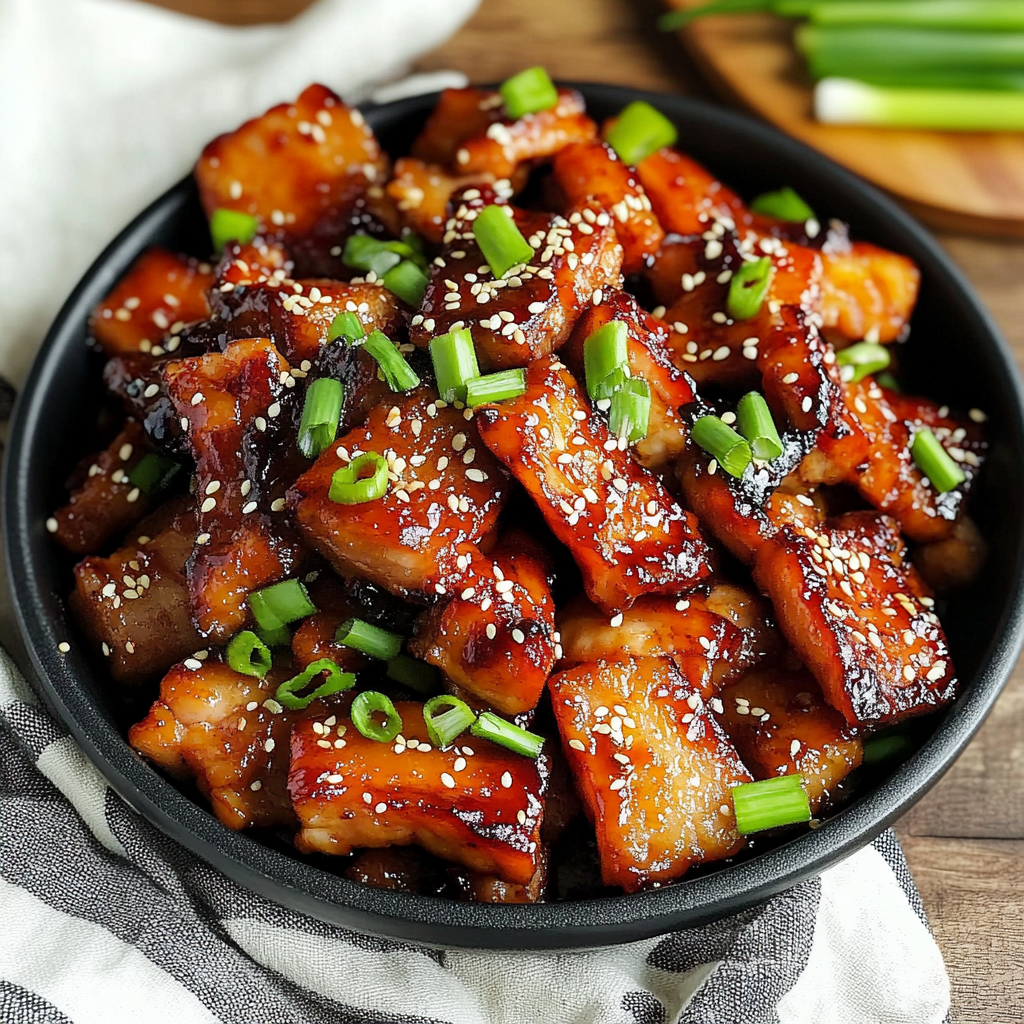This Korean Pork Belly Skillet is a savory, satisfying dish with bold and spicy flavors that come together in just 30 minutes. Gochujang and gochugaru provide heat and depth, while sesame oil and honey add a touch of sweetness and balance. Each bite of pork belly is seared to crispy perfection, giving it that irresistible texture.
Perfect for fans of Korean cuisine or anyone looking for a new weeknight dinner staple, this dish pairs beautifully with steamed rice and fresh veggies. It’s easy to prepare and even easier to love — a must-try for anyone who enjoys vibrant, full-bodied flavors in their meals.
Full Recipe
Ingredients:
-
1 teaspoon finely chopped fresh ginger
-
3 tablespoons Korean red pepper paste (gochujang)
-
1 tablespoon Korean red pepper flakes (gochugaru)
-
1 tablespoon soy sauce
-
1 tablespoon toasted sesame oil
-
1 tablespoon honey
-
1/4 teaspoon ground black pepper
-
1 pound pork belly (skinless, sliced into 2 to 3-inch pieces, about 1/8-inch thick)
-
1 small onion (sliced thinly after halving)
-
4 green onions (cut into 2-inch lengths, plus extra for topping)
-
Toasted sesame seeds (for topping)
Directions:
-
In a medium bowl, combine the ginger, gochujang, gochugaru, soy sauce, sesame oil, honey, and black pepper. Mix thoroughly to create a marinade.
-
Add the pork belly slices, onion, and green onions to the bowl. Stir to ensure everything is evenly coated. Let sit for 10 minutes.
-
Heat a large skillet over medium-high heat. Add the marinated pork belly and vegetables.
-
Cook for 12–15 minutes, stirring occasionally. For crispy edges, let the pork sit undisturbed for 2–3 minutes at a time before stirring.
-
Once cooked and caramelized, transfer to a serving dish. Top with toasted sesame seeds and additional green onion. Serve hot.
Prep Time: 15 minutes
Cooking Time: 15 minutes
Total Time: 30 minutes
Kcal: Approximately 1800–2000 kcal (entire recipe)
Servings: 4 servings
Introduction to Korean Pork Belly Skillet
The Korean Pork Belly Skillet is a sizzling, flavor-packed dish that celebrates the rich, bold flavors of traditional Korean cuisine with the convenience of a one-pan meal. At its core, this recipe takes succulent slices of pork belly and bathes them in a savory-sweet marinade made from classic Korean ingredients like gochujang (fermented red chili paste), gochugaru (Korean red pepper flakes), soy sauce, honey, sesame oil, and fresh aromatics like ginger and green onions.
Pork belly is a beloved ingredient in Korean cooking, often featured in dishes such as samgyeopsal (grilled pork belly) and bossam (boiled pork belly served with wraps and condiments). What makes this skillet version so special is its ease of preparation and the way the flavors meld and concentrate as the pork cooks. The fat from the pork belly renders down in the hot pan, creating a crispy, caramelized texture that’s deeply satisfying and full of umami richness.
Cultural Significance of Pork Belly in Korean Cuisine
In South Korea, pork belly (known as “samgyeopsal”) is more than just a popular cut of meat—it’s a cultural icon. It’s often enjoyed in social settings, where diners gather around a grill, cooking and sharing the meat with side dishes like kimchi, pickled vegetables, garlic, and lettuce leaves for wrapping. This communal dining style emphasizes connection and togetherness, which is central to Korean culinary tradition.
The skillet version pays homage to this communal experience but transforms it into a more practical format for the home cook. Instead of requiring a tabletop grill and multiple components, the dish can be made entirely in one pan and served as a hearty main course.
Flavor Profile and Texture
What makes this Korean Pork Belly Skillet so irresistible is its perfect balance of flavors and textures. The gochujang adds depth, heat, and a touch of tanginess; gochugaru provides an earthy spiciness; honey gives a gentle sweetness; while sesame oil infuses the entire dish with nutty richness. The combination is nothing short of addictive.
As the pork belly cooks, it develops a beautifully crispy exterior while remaining juicy and tender inside. The onions and green onions absorb the marinade and caramelize along with the meat, contributing sweetness and complexity. The result is a sticky, savory coating that clings to every bite.
Why This Dish Is Great for Weeknights
With a total cooking time of about 30 minutes, this dish is an excellent choice for busy weeknights when you want maximum flavor with minimal effort. Everything is done in a single skillet, reducing the need for multiple pans or complex preparation techniques. Most of the ingredients are pantry staples in a Korean or Asian-style kitchen, and even if you’re new to Korean cooking, the ingredients are becoming increasingly accessible in grocery stores and online.
Another key benefit is that this recipe doesn’t require marinating overnight. A brief rest in the marinade while prepping the skillet is enough to impart the pork with deep flavor, which is then intensified during cooking.
How to Serve Korean Pork Belly Skillet
This dish is best served hot, straight out of the skillet. Traditionally, pork belly in Korean cuisine is eaten with steamed white rice, which helps balance out the spice and soak up the savory sauce. For a well-rounded meal, you can serve it alongside kimchi, sautéed spinach, pickled radish, or even a quick cucumber salad to add freshness and contrast.
Another fun way to enjoy this dish is to use lettuce leaves as wraps. Add a spoonful of the pork belly mixture to a lettuce leaf, top with a slice of garlic, a dab of ssamjang (a fermented soybean paste), and a few strands of green onion. Roll it up and enjoy—no utensils needed!
For fusion-style presentations, try serving it over noodles, inside bao buns, or even on tacos. The bold flavors pair well with a variety of textures and formats, making this an adaptable recipe for creative cooks.
Tips for Best Results
To ensure your Korean Pork Belly Skillet turns out perfectly every time, consider the following tips:
-
Use thinly sliced pork belly: This allows the meat to crisp up quickly and evenly while absorbing the marinade better.
-
Don’t overcrowd the pan: Cooking in batches ensures that the pork browns instead of steams.
-
Let it crisp: Give the pork a few undisturbed minutes in the pan to develop that signature caramelized crust.
-
Balance the heat: Gochujang and gochugaru can vary in spice level depending on the brand. Taste and adjust to suit your preference.
-
Use a cast iron or heavy-bottomed skillet: These hold heat better and help create a better sear on the pork.
Health Considerations
While pork belly is a fattier cut of meat, it’s also rich in flavor and protein. Moderation is key, as with any indulgent ingredient. One way to lighten up the dish is to serve it with plenty of vegetables or opt for smaller portion sizes served with a large salad or broth-based soup.
Additionally, this dish can be made gluten-free by using gluten-free soy sauce or tamari. You can also control the amount of sodium and sugar depending on dietary needs by adjusting the soy sauce and honey in the marinade.
Why You’ll Love This Dish
This Korean Pork Belly Skillet is the kind of meal that delivers restaurant-level flavor with very little effort. It’s quick, customizable, deeply flavorful, and offers a satisfying crunch in every bite. Whether you’re new to Korean cuisine or a seasoned fan, this recipe is approachable and endlessly enjoyable.
It’s also great for meal prep. Leftovers reheat well and can be used in rice bowls, noodle dishes, or even breakfast scrambles. You’ll find yourself returning to this recipe again and again, not just for its taste but also for its simplicity and versatility.
Conclusion
In the world of fast and flavorful meals, the Korean Pork Belly Skillet holds its own as a standout dish. It’s rich with traditional flavors yet modern in its execution, offering the best of Korean culinary culture in a format that fits today’s busy lifestyle. It’s a celebration of texture, flavor, and balance—all achieved in a single skillet.
Whether you’re looking to impress dinner guests, feed a hungry family, or treat yourself to something extraordinary on a weeknight, this dish delivers every time. Crispy, spicy, sweet, and savory—it checks every box. Once you try it, it’s bound to become a permanent part of your cooking rotation.






